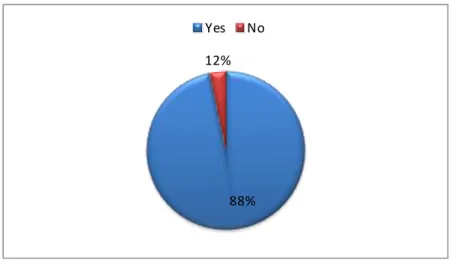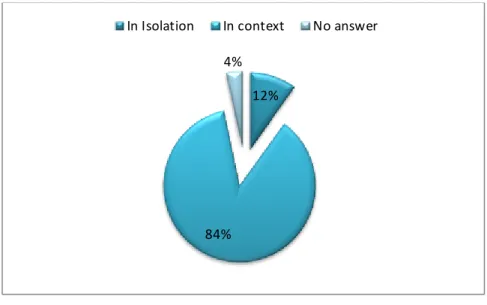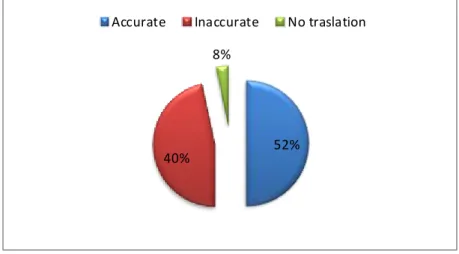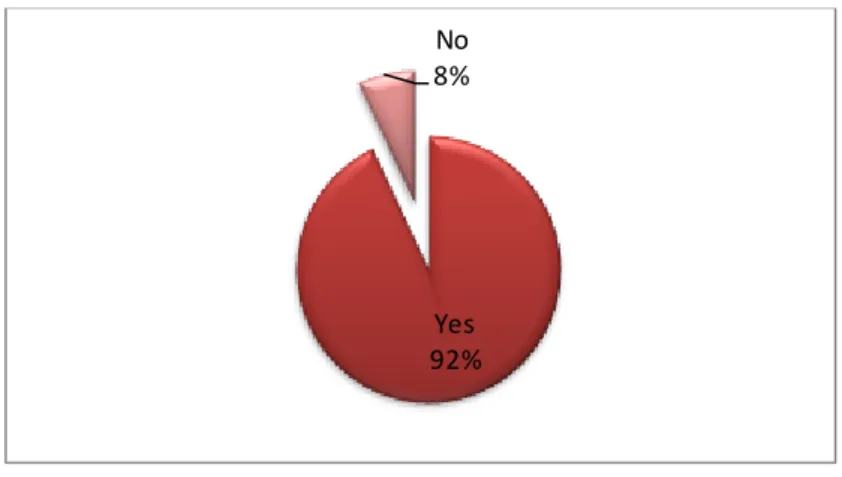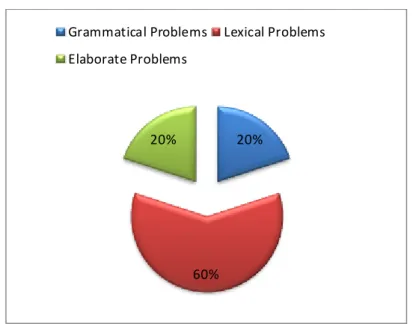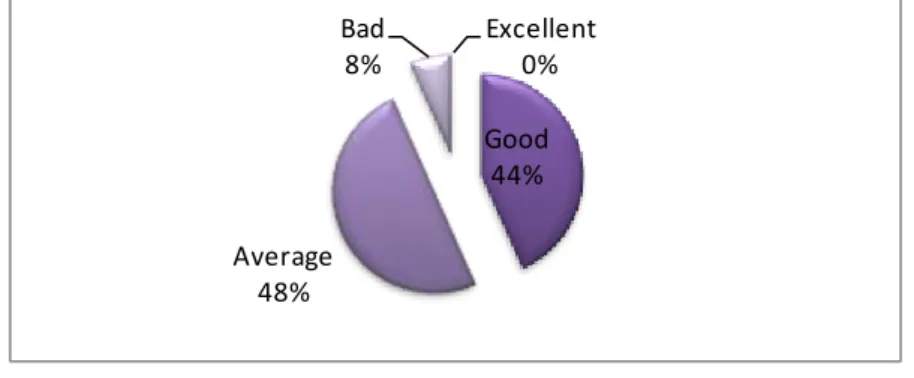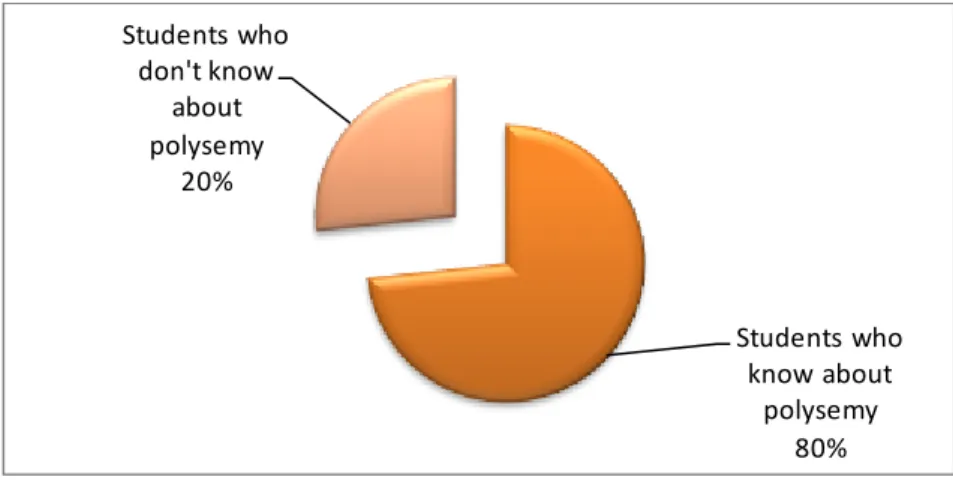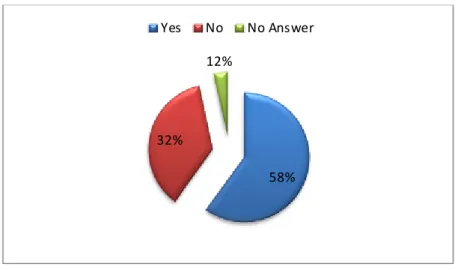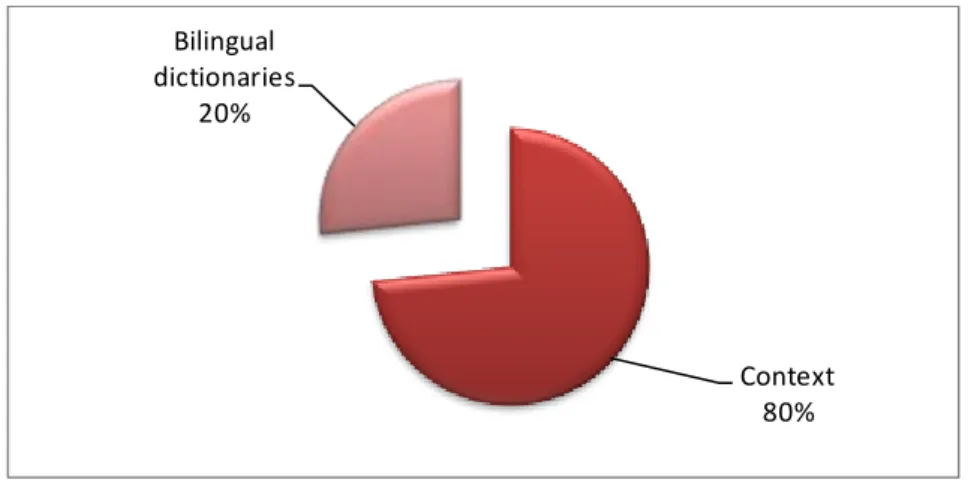Ministry of Higher Education and Scientific Research Abdelhamis Ibn Badis University of Mostaganem
Faculty of Letters and Languages Department of English
Students’ Perceptions towards the Role of the Context in Solving Problems of
Misunderstanding when Translating Polysemous Words from English to Arabic
Case of Second Year Master Students of English Language And Linguistics At Abdelhamid Ibn Badis University of Mostaganem
Prepared by: Mohammedi Tounsia
Supervised by: Dr. Neddar Bel Abbes
Examined by:
- Dr. S. Hamerlain M.C.A Chairwoman University of Mostaganem - Ms. F. Hairech M.A.A Examiner University of Mostaganem
I
I would like to express my thanks to my teacher and supervisor Dr.
Neddar Bel Abbes, for his help, guidance, suggestions, understanding and
valuable comments on my memoire. Special thanks to the board of examiners
for their time and effort. Also, a special thanks to my colleagues for their
cooperation in this modest work.
ii
I dedicate this work to:
- My dear parents
- My brother and sisters
III In this final memoire, we try to explore second year master degree students’ knowledge about the importance of context when translating polysemous words from English to Arabic. The objective of this work is to confirm two hypotheses: if second year English Master degree learners of English Language and Linguistics at Abd Elhamid Ibn Badis university consider the context, they will choose the right meaning of polysemous words; and if the learners do know the different meanings of the polysemic word, they will translate it effectively in various contexts. A questionnaire has been designed to find out if our hypotheses are valid or not, it was presented to a random group of second year master degree students. The results show that these students know exactly what role the ‘context’ plays during the translation process. Moreover, it proves that knowing the different meanings of a polysemic word gives the students the opportunity to be more accurate in their translation. Finally, some helpful pedagogical recommendations are stated to increase students’ capacities in translation.
IV Acknowledgements ………..……….………….……….………..I Dedications... II Abstract... III Table of Contents………..………..…IV List of Tables ... VII List of Figures ... VIII
Introduction...1
Statement of the Problem …..…………...……...1
Aims of the Study ………...………..…1
Research Questions ………….………...1
Hypotheses ……..……….……...1
Research tools ...……….2
Subjects ……….………..………..…2
Organization of the Thesis ………….………...…………2
Chapter One: An Overview On Context and Translation Section One: The Notion of Context………...……...………….4
Introduction………..………4
1.1. The definition Context ...4
1.2. The role of context……….……….7
Section Two : Translation………...……....8
1.3.Definition of Translation………...………….…..8
1.4. Sorts of Translation………...………..…9
1.4.1. Literary Translation ………...………10
V 1.4.3. Informative translation ………...…………..…….11 1.5. Issues of Translation………...…..11 1.5.1. Grammatical Issues……….………...12 1.5.2. Lexical Issues……….…………..…..12 1.5.3. Elaborate Issues……….……….13
1.6. The Qualities of a Good Translator………...…13
1.6.1 Tips for translators’ attention………..14
Conclusion………..….16
Chapter Two: Semantic and Polysemy Introduction………...……….17
2.1.Definition of Semantics………..17
2.1.1 Lexical Structure in Semantics………18
2.1.1.1. Polysemy ………18
2.1.1.2. Notion of Polysemy in Arabic ……….…………...…19
2.1.1.3. Homonymy ……….………20
2.1.1.4. The distinction between Polysemy vs. Homonymy…….………...…20
2.1.1.5. Translation and Polysemy……….……….…….22
2.1.1.6. Lexical Ambiguity and Polysemy………..………….…24
1.3. The role of bilingual dictionaries………..………26
Conclusion………..………26
Chapter Theree: Data Analysis Introduction………....28
3.1. The Sample ………...28
3.2. Research Tools ……….28
VI
3.2.1.1. Description of the Questionnaire……….………28
3.2.1.2. Analysis……….………..29
3.3. Summary of the Findings………..…38
Conclusion ……….………39
General Conclusion……….………..40
Bibliography………..………….42
VII
Table 1: Students’ awareness about Context………...…29
Table 2: Students’ use of the context in translation………30
Table 3: students’ translation of the sentence……….………31
Table 4: student’s practice of translation……….32
Table 5: Students’ Difficulties in Translation……….……32
Table 6: Students’ problems during translation………..………33
Table 7: students’ level in translation……….……34
Table 8: Student’s relation with polysemy………..……35
Table 9: Using the Dictionary for Translating Polysemous Words………36
VIII
Figure 1: Students’ awareness about Context………..………29
Figure 2: Students’ use of the context in translation……….……….…..30
Figure 3: students’ translation of the sentence………..………….…..31
Figure 4: student’s practice of translation………..…….…….32
Figure 5: Students’ Difficulties in Translation……….…………....33
Figure 6: Students’ problems during translation……….……….………34
Figure 7: Students’ level in translation………..…….……….35
Figure 8: Student’s relation with polysemy……….………....36
Figure 9: Using the Dictionary for Translating Polysemous Words……….………..…37
1
Statement of the Problem
Learners face many problems when translating from English to Arabic. One of the most occuring problems happens at the lexical level. Words with several meanings raise ambiguity when used in idioms, synonymy, homonymy, and polysemy. Polysemy, known as being a liguistic phenomenon, deals with problems that occur when words are decontextualised or put with the monosemous words category.
Aims of the Study
In this research work, the light spot is put on the student’s selection of polysemous words during their translation work. The next aim is to find the best ending to these problems that learners may deal with as a result of some misunderstanding.
Research Questions
The primary questions that are raised are:
1- What are the most adequate techniques for students to end up with a good translaion of polysemous words from English to Arabic?
2- Is the context taken into consideration when students select the equivalent words in Arabic of English polysemoys words ?
Hypotheses
2 1- If second year English Master degree learners of English language and linguistics
at Abd Elhamid Ibn Badis university consider the context, they will choose the right meaning of polysemous words.
2- If the learners do know the different senses of the polysemic word, they will decipher it effectively in various settings.
Research Tools
A questionnaire was designed to find out if our hypotheses are valid or not. We picked up a random group of second year Master degree learners of English language and linguistics at Abd Elhamid Ibn Badis University and we gave them the questionnaire.
Subjects
We have randomly selected the second year Master degree learners of English language and linguistics at Abd Elhamid Ibn Badis University since they have already dealt with polysemy and have practised translation for a period of more than four years,
that is to state, they have obtained the standards of interpretation and have seen words in various types of settings with various types of words.
Organization of the Thesis
The thesis is divided into three chapters: Two theoretical and one practical. The first chapter is a kind of an overview about translation and context; it consists of two major sections. The first section is about the role of context, where we dealt with the importance of context in selecting the correct meanings of words; giving out its various definitions of context proposed by different scholars. The second section consists of the definition of translation and its different type and then ending with some issues that face translators and some qualities of good translators
3 The second chapter is devoted to semantics and polysemy. we will discuss a few researchers' perspectives concerning both polysemy and semantics; there is distinction between polysemy and homonymy considered as the main cause of lexical ambiguity. This chapter discus some problems that are caused by polysemy and the last point will be about the advantages of the bilingual dictionary.
The third chapter is practical. It is concerned with analysis of the results obtained. The questionnaire is addressed to a sample of 25 students. The purpose behind this questionnaire is knowing whether students have an idea about the role of context in translating polysemous words and also to valid the research hypothesis.
3
Introduction
This chapter plans to give a concise overview on context and translation, this chapter is
divided into two major sections. The first section is about the role of context and its effect on
choosing the correct meaning of polysemous words, giving out its various definitions, concerning
the second section, it provides information about translation, begins with its various definitions,
and presents the different sorts of translation which includes literal, informative and technical one,
It additionally deals with the impediments and issues that interpreters and the student may face
during the translation process, among which are the grammatical issues. Finally the chapter ends up
with some qualities of good translators.
Section One: The Notion of Context
1.1. The definition of Context
The context has been defined in deferent ways, and the most common point between the definitions that are given to the context is that it disambiguates between possible meanings. In fact context is flexible, it requires the connexion between the speaker and the hearer in particular situation, and this relationship must not necessarily be purely linguistic.
George Yule (2002) also took the notion of context into consideration and he stated that “Context is the physical environment in which a word is used” (Yule, 2000, p.128). It means that the context is where the action is happened and when. "Context is typically the location, identity and state of people, groups, and computational and physical objects" (Dey et al., 2001, p.97). He supported his idea by saying that “Context is any information useful to characterize the state of individual entries and the relationship among them” ( Dey et al., 2001, p.97).
4 According to Dey (2001), the context is any acquired fact that describes an entity. This entity is referred to “any person, place, or object that is considered relevant to the interaction be-tween the user and the application, including the user and the applications them-selves” (Dey, 2001, p.4).
Numerous language specialists described the context from various perspectives as per their own particular fields with a specific end goal to bolster their own thoughts, and hypotheses.
Linguists give diverse definitions to the term context as per their hypotheses and researches. Halliday (1999) sees that context in some kind of condition, it is what is circumventing where language is utilized, Halliday (ibid) tries to give a definition to the term . He demonstrates that the term is utilized to allude to what is before and after a word or a text. Where he stated that “the context meant the accompanying text, the wording that surrounds what is under attention” (Halliday, 1999, p.3). The idea of context used to allude just to the language however, and just in current linguistics that the term gets significance, in present day semantics has a connection with the environment in which the language is utilized (ibid) .
Present day linguistics sets up the utilization of the context out of language, by making another term „„co-text‟‟. He expresses that Catford who requested an alternate idea to allude to the verbal environment to supplant the thought of context which is utilized to allude to the non-verbal environment (ibid).
Cook (1999) contemplated also the concept of “context” when he concentrated on the connection between discourse and literature. According to him, context is only a type of information the word. Cook (ibid) expressed that the term “context” can be utilized as a part of a wide and limited sense. In the limited sense, context alludes to elements outside the content under consideration. In the wide sense, context alludes to learning of these
5 elements and to information of different parts of the content under consideration, once in a while alluded to as “co-text” (cook, 1999, p24).
Widdowson concentrated his research on language meaning. He characterizes context as those parts of the situation of real language use which are taken as important to significance (2000). He additionally called attention to, "in other word, context is a schematic construct the achievement of pragmatic meaning is a matter of matching up the linguistic elements of the code with the schematic elements of the context” (Widdowson, 2000, p.126). Griffiths (2006) stated a very expressive definition of the context, according to him “Context facilitates disambiguation (between the „final‟ and „previous‟ meanings of last) and helps establish what things are referred to when the second individual in each scenario uses the expressions” ( 2006, p.7).
To Griffith, the context doesn‟t belong to Semantics but to Pragmatics. Where he said that,” If you are dealing with meaning and there is no context to consider, then you are doing semantics, but if there is a context to be brought into consideration, then you are engaged in pragmatics” (Griffith, 2006, p.6).
Palmer states that some semanticists ask to omit the context from Semantics “we have already noticed that there are linguists who, explicitly or implicitly, exclude context from the study of semantics” (palmer, 1976, p.43-44), because they believe that ambiguity and anomaly can be made clear without the context since the meaning is obvious to the language users, in addition, it is independent from any context (ibid). The following two sentences present anomaly and ambiguity;
1."My typewriter was bad intentions” (Palmer, 1976, p.45). 2." John was looking for the glasses” (ibid).
He recognises that the first sentence is abnormal and the second in unclear; So, that to find the irregularity and the abnormality, we have to hold the suitable information about
6 type-writers and kinds of glasses (ibid, 45).In other words, there is a demand for context to acknowledge both irregularity and abnormality problems as parts of Semantics.
1.2. The role of context
The context often helps to eliminate problems of misconception or uncertainty and to disambiguate between potential meanings. According to l, Lewis Thomas (1974, p. 94) wrote that "ambiguity seems to be an essential, indispensable element for the transfer of information from one place to another by words, where matters of real importance are concerned."
The role of the context is in making and assessing meaning and comprehension. It is important to solve any problems of misunderstanding. We often use the context both explicitly and implicitly in most all that we do with languages. Moreover, Context plays a crucial role, not only in disambiguity, but also in Translation for instance; we cannot translate without relying on context.
The context of a particular conception or occasion is the general situation that identifies with it, and which helps it to be clear (Collins Co-build Dictionary, 1995). Ambiguity alludes to any word, expression, sentence or group of sentences with several meanings. There are a lot of sorts of ambiguities, for instance, Lexical equivocalness is generally brought about by homonymy and polysemy. For example, these two words, see and sea, are altogether articulated as /si:/, but they are different in meaning.
We typically use such words like she, he, you, this, that, and so forth to avoid problems of repetition and to supply an equivalent adverbial phrase of time and place. In this manner, the context helps to guess the interpretation of such words and to what they refer. The context uncovers how the terms are being utilized, that is its part in the specific context.
7
Section Two: Translation
1.3. Definition of Translation
Translation is a process that has a lot of features. It helps people to exchange ideas and equipment that cannot be dispensed with in our daily life. Translation carries several meanings: it is a pragmatic movement that includes transforming one dialect into another; this implies that translation carries a meaning from one language to another. It is an effort of finding equivalent meaning of a text into the second language.
Translation has turned into the concentration of the present studies; it aims at converting the meaning of a given linguistic discourse from one language to another more than the words of the source language. Translation is a process consisting in "reproducing in the receptor language the closest natural equivalent of the source-language message, first in meaning and secondly in style" (Nida & Taber, 1969, p. 12). Nida (1981, p.2) added, “Translation means communication because it has three essential elements to form a process of communication. The three essential elements are source, message, and receptor, and these elements must be found in all communication activities”. Translation is seen as a tool of communication because it has some communicative features like, the source, the message and the receptor.
Translation is characterized by researchers from multiple points of view. Yowelly and Lataiwish (2000), describe translation as a term of replacing a text with another text in two different languages. Similarly, Catford(1965) concentrates on the translation of text. He says that translation is an operation of replacing a text in one language into another language (ibid.). Where he characterizes translation as "the replacement of textual material in one language (SL) by equivalent textual material in another language (TL)" (Catford, 1965, p.20). In this way, both researchers focus on the translation of text.
8 For example the two following English sentences with their equivalents in Arabic:
1) I have been waiting for long time. يف تنك دقل
لاا ةليوط ةرتفل راظتن 2) That girl is sick
ةضيرم ةاتفلا كلت
There are different researchers who concentrate on the translation of meaning, such as, Ghazala (1995), he expresses that the only thing will be deciphered is meaning. Ghazala's definition focuses on the notion of meaning as an essential component in translation.
Abdallah (2002) claimed that Translation issues can be separated into linguistic issues and cultural issues: the linguistic issues incorporate grammatical differences, lexical ambiguity and meaning ambiguity; the cultural issues allude to various situational features. Our main concern here is lexical ambiguity because this research is dealing with words; particularly polysemous as being a type of those words that create ambiguity in meaning.
1.4. Sorts of translation
Translation is considered as a tool of interlingual communication; it has been invented new terms and expressions to describe different services of translation that doesn‟t have any relation with the usual categories like machine translation or human translation, this because of the great evolution that occurs in the world of the translation. The concept of translation gives translator various means of analysis, which enable him to be aware of what to pick from the original text, what type of data he must carry in TT, and what he should do to achieve his purpose. The process of translation made of two different mental processes which are understanding and verbalisation. In very first one the translator
01 get the meaning of what have been said in ST which enable him to develop this idea into TT.( Г.М. Кузенко,2008)
Any sort of translation has a great influence on the translation process, there are a lot of types of translation , and each type depend on the communicative function of the source language, so that we can make distinction between literary and informative translation and between oral and written one. The concept of the translation becomes unlimited and varied one. It exists various methods and several theories about translation in more than one or two types of translation including literary translation, Informative translation, and technical translation. (ibid).
1.4.1. Literary Translation
It is considered as the most complicated kind of translation it requires a capable translator because it deals with poems, novels and sometimes plays, he must be proficient in transmitting the right feelings and emotions. It “deals with literary texts, i.e. works of fiction or poetry whose main function is to make an emotional or aesthetic impression upon the reader. Their communicative value depends, first and foremost, on their artistic quality and the translator‟s primary task is to reproduce this quality in translation.” ( Г.М. Кузенко, 2008, p.9). In addition to poetry and plays there are Polysemic words which cause problems in their translation because behind each word or a phrase, there is number of connotations where the writer finds some difficulties in transmitting the message if the source text.
1.4.2. Technical Translation
In this type, the translator must master the technical terms and should have a sufficient understanding about the subject that he is dealing with, in order to transmit the correct sense and give the right description of the subject. The translator has to respect the
00 stylistic requirements of scientific and technical materials to make the text more clear and acceptable to the specialists (ibid). So, technical translation needs a sufficient knowledge of a specific terminology used in the domain originating the text, such as mechanics, electronics, and industrial texts in general. He added that “some types of texts can be identified not so much by their positive distinctive features as by the difference in their functional characteristics in the two languages”(ibid).
1.4.3. Informative translation
The primary aim behind this kind of translation is to transmit a specific ideas or thoughts, to inform the readers. But sometimes the translation of the source text is considered as literary or informative translation because of its length. It is consists of some elements informative character. Informative translation may contain a few components gone for accomplishing an aesthetic impact (ibid). The main purpose of this type is to transfer information, ideas, and event to tell people and inform them. “Literary works are known to fall into a number of genres. Literary translations may be subdivided in the same way, as each genre calls for a specific arrangement and makes use of specific artistic means to impress the reader”( Г.М. Кузенко, 2008, p.9)
1.5. Issues of Translation
Professionals strive to find solutions to translation problems that‟s why they work hard to find the reasons that could be the result of these issues. According to Palumbo (2009) the main issue of the translation can be define in this simple question “what makes a text difficult to translate” (palumbo, 2009, p.36). Having background knowledge of particulars languages this doesn‟t mean how to decipher.
01 Differences in the source and the target languages is the principle problem that cause problems in the translation process especially in the domain of culture, this pushes the translator to use some tools to check the correct meaning of words, in addition to the problems of ambiguity, we find the grammatical problem which cause some difficulties to the translation because there are some complicated grammatical structure that are poorly understood, Ghazala (1995) states that these issues are mainly originated from lexical and structural differences that are found between different languages.
1.5.1. Grammatical Issues
According to Ghazala (1995), The English grammar has different tenses which do not exist in the Arabic language, because English and Arabic belong to two different language families. For instance there is no present perfect tense in the Arabic language. Because the present perfect has a present connotation, which might be lost when translated in the past tense in Arabic. For example. For example, “we have fought against this injustice.” It is translated as follows: “ملظلا اذه دض انبراح” but it is preferable to be translated as follows: “ملظلا اذه دض براحن”, because the speaker points at the continuing present
1.5.2. Lexical Issues
Translation becomes a complicated process because of the Lexical differences between English and Arabic. As Ghazala (1995) states, the translators may find some difficulties in deciphering some keys words, because he is unfamiliar with such words. Sometimes the translator is not able to choose the right terms because he may not encounter the equivalent meaning this because of synonymy, polysemy or homonymy.
02 Any word cannot have meaning without due regard to the specific context in which it is actualized. As it is mentioned before the principal lexical problems that the translator may encounter are:
a. Polysemy and monosemy: translators cannot make the difference between the two and they give one meaning in all cases.
b. Synonymy: Translators cannot distinguish between some words that have the same meanings because they could not replace each other.
1.5.3. Elaborate Issues
Style is a critical piece of significance which may bring about issues in interpretation in the event that it is not contemplated (Ghazala, 1995). The expressive issues that may confront interpreters are at the level of:
a. Ambiguity: It represents a great issue in interpretation. The interpreter can't get the expected implications in light of the style of vagueness. This prompts the unsettling influence of the genuine message of the source content (ibid).
b. Formality: Since every dialect has its degrees of convention, the interpreter may confront issues due to absence of mindfulness about formal and casual dialect.
1.6. The Qualities of a Good Translator
A decent translator is the one who has a background knowledge of the source and the target language as well, students have to be familiar with more than one genres in both languages, that is to say that they have to read newspapers, magazines and especially modern literature, etc. As indicated by Shahvali (1997), preparing students to confront the advancements in the field using theoretical learning and practical skills abilities is not
03 sufficient. There is a requirement for ability to adjust; in this manner, it is important to teach the students how to build up their relevant mental, communication, and arranging abilities. Specific reading also contribute in improving different skills, and also give them ideas where they will apply them during translating.
The translator's task is to make conditions under which the source language writer and the target language reader can interface with each other (Lotfipour, 1985). Preparing translators is a critical task which must to be given a high priority. Translators are the operators for exchanging messages from one language to another, while preserving the underlying cultural and discoursal thoughts and qualities (Azabdaftary, 1997).
A decent translator ought to be acquainted with the culture, traditions, and social settings of the source and target language speakers. He should also be familiar with different registers, styles of speaking, and social stratification of both languages. In this way, the translator will transmit not only the meaning of the target text, he will also transmit the culture of the target readers, and this this helps the target readers to understand and decode the deciphered text.
This socio-cultural knowledge can improve the quality of the students' translations to a great extent. According to Hatim and Mason (1990), taking the socio-cultural context into consideration while translating is the only way to have a successful translation. The social context in translating a text is probably more important than its genre. Subsequently, it is essential to judge interpreting movement just within a social context.
1.6.1 Tips for translators’ attention
Robinson (1997, p.49) has recommended that the translator is a learner and he proposes that "translation is an intelligent activity involving complex processes of conscious and unconscious learning."
04 There are a lot of critics that leads the translator to be a specialist, the very first and important thing is „reading‟ because receptive skills should be developed before the productive ones i.e. The translator must have an interior knowledge in order to be creative, and this enhances the translators‟ language instinct and makes them prepared for real interpreting. Translators must be passionate about their translation work. They should use different methods and efforts to convey the right message of the source language.
The actual translator does not need to check to the meaning of terms with the help of dictionaries to find their adequate meaning in the target language, but he must respect the rules and the style of the source language to convey the real meaning. The deciphered version must be conveyed in a way that sounds regular and natural, it must be meaningful to the target reader. The translator must have the capacity to comprehend the greater part of written works without the guide of a lexicon.
According to Ainon Muhammad (1979), a good translator must be a subject specialist, master the source language, better the target language, and he must have knowledge of different translation theories and practice. For instance if the translator want to tackle a scientific subject, he must receive science training. Robinson (1997, p.51) proposes that "translation is an intelligent activity, requiring creative problem-solving in novel, textual, social, and cultural conditions." The cognitive information is important in the process of translation and the translation must be aware of its importance.
Sager (1994) proposes that the translator must assess, modify, adjust and then he can show and publish. Just like a written work, translating too includes these stages. According to Smith-Worthington and Jefferson (2005) some planning are included during the process of translation like (prewriting, shaping, researching), then it comes the (proofreading and publishing).
05
Conclusion
Translation plays a crucial role in transmitting meanings, it facilitates communication between people and it helps in understanding different languages, and also in exchanging knowledge between two different cultures, but the translator should be sure that he has chosen the adequate meaning, in this case the only thing that will be helpful is the „context‟, because he may encounter obstacles and issues in his translation especially with words that have more than one meaning .So, the main concern of this phenomenon is disambiguate „meanings‟. The context helps students to transmit actual message of the source language into the target language. Moreover, the translation do not require to transmit the meaning, emotions and feelings must also be reproduced.
71
Introduction
This chapter will be devoted for polysemy, we will discuss a few researchers' perspectives concerning both polysemy and semantics, we will provide some linguists „definition about homonymy and it relation with polysemy which are considered as the main cause of lexical ambiguity, then we move to talk about the relation between translation and polysemy. Polysemy causes some issues to translation, because it is considered as sorts of ambiguity, moreover, the polysemy is a phenomenon that we can find in each language. finally, the last point will be about the advantages of the bilingual dictionary.
2.1. Definition of Semantics
The notion of semantics is described by various linguists, and the most frequent definition is the study of meaning (Lyons (1984). According to Palmer (1976, p.1) “semantics is the technical term used to refer to the study of meaning”. He added that „semantics‟ is a new term added the English language (ibid). Yule (1985, p.112) describes semantics as “the study of the meaning of words, phrases and sentences». The interest is in meaning more than anything else (ibid). Langacker (1987, p.12) for example, talks about the importance of meaning in all linguistics aspects, According to him:
Meaning is what language is all about; the analyst who ignores it to concentrate solely on matters of form severely impoverishes the natural and necessary subject matter of the discipline and ultimately distorts the character of the phenomena described.
Yule (1996, p, 114) brings another view to the term of semantics where he focuses on the actual meaning of the word rather than what the speaker means:
71 Semantics is the study of the meaning of words, phrases and sentences. In semantic
analysis, there is always an attempt to focus on what the words conventionally mean, rather than on what a speaker might want the words to mean on a particular occasion. This technical approach to meaning emphasizes the objective and the general. It avoids the subjective and the local. Linguistic semantics deals with the conventional meaning conveyed by the use of words and sentences of a language. As the meaning is the main concerns of semantics the interest is in “the relation between linguistic units, such as words and sentences, and the world” (Jaszczolt, 2002, p.2). The study of semantics argue that each words, phrases or expressions carry a certain meaning and these words informs us about different events that occurs in the actual world. “Everything in language conspires to convey meaning” (Wierzbicka, 1988, p.1).
2.1.1 Lexical Structure in Semantics
There is always certain confusion between the concept of polysemy and homonymy this causes some problems of meaning, many researchers and linguists try to differentiate between them. And this relies on the study of relations among the meanings.
2.1.1.1. Polysemy
Polysemy is one of the most important vital of modern linguistic semantics, According to Yule (1996), it can be defined as a written or spoken words that have more than one meaning which are all connected by prolongation. That is to say that meanings are related to each other, For instance the word „head‟ is allude to the organ on top of human body, on top of any glass of beer or on top of any organisation or department (ibid). “Not only do different words have different meanings; it is also the case that the same
71 word may have a set of different meanings. This is polysemy; such a word is polysemic” (Palmer, 1976, p,100).
According to Taylor (1989, p.99), “Polysemy is the association of two or more related senses with a single linguistic form”, it means the ability of one word to have several meanings. The ability to name the different objects with the same name preserving common features this is called polysemy (Arnold 1986). It means the ability of words to have more than one meaning.
Meaning system changes through time, so that new terms added to the language. “Synchronic pattern of meanings surrounding a word, which is itself the ever changing result of semantic change” (Cuyckens, Zawada, 2001, p.85). Kennedy (2002, p.67) explains that polysemy is the reality that: “some words may have more than one meaning (or even many).” So polysemy is that phenomenon which “means that one word can have more than one sense” Ullman (1957, p.117).
2.1.1.2. Notion of Polysemy in Arabic
Polysemy is a phenomenon that we can find in each language, Middle Easterner analysts and etymology specialists have explored the thought of polysemy. This linguistic marvel exists even in the Arabic language it is refered to as „يظفللا كرتشملا‟ „ishtirak lafdi.‟ They additionally trust that it is a single word with various implications. Besides, Polysemy exists in various languages not just in Arabic and English. The accompanying cases could show the presence of polysemous words in both Arabic and English; in English word we find the three meanings illustrated with „head‟ it can means “the object on top of your body, on top of a glass of beer, on top of a company or department” (Yule, 1996, p97). In Arabic, for instance the word „ةبيقح‟has distinctive implications which could be deciphered accurately relying upon the setting where it is utilized, for example, „رفس ةبييقح‟
02 refers to a traveling bag (suitcase), „بيبط ةبيقح‟ Doctor's suitcase, „ءاسنل ةبيقح‟Which refers to a bag,. Subsequently, this semantic concept could be a terrible obstacle for the translator to choose the correct sense among the different meanings of a given polysemic word. According to As-Suyüti (1971) the polysemy contributes in improving the language, and makes it more capable to describe what happens around us.
2.1.1.3. Homonymy
Homonymy are less well-known terms which are often used to connect between the linguistic units in a language. According to Yule (1996, p. 97) “The term homonymy is used when one form (written and spoken) has two or more unrelated meanings” it means that homonymy refers to different words sharing the same name. For example, “the pairs bank (of a river) - bank (financial institution), bat (flying creature) - bat (used in sports), race (contest of speed) - race (ethnic group), pupil (at school) pupil (in the eye) and mole (on skin) - mole (small animal)” (ibid).
Homonymy are two words that do not share the same structure or grammar, there are two types of homonymy: homography and homophony. Homographs: They are words that have different meaning and pronunciation but they share the same meaning such as „bark-bark‟. Homophones: They have different meaning and spelling but they have the same pronunciation, such as: „write-right‟ (Jaszczolt 2002).Homonymy is viewed as a vague phenomenon, the problem occurs when words and expressions have multiple meaning but they are not synonyms.
2.1.1.4. The distinction between Polysemy and Homonymy
Polysemy and homonymy looks similar, to make it easier, polysemy are words with similar meaning and form, in other word, polysemy is defined as one form with several
07 meaning, just as it is stated by Jaszczolt (2002), there is a collections of a lot of meanings which go to the identical word and that what is called polysemy. Homonyms are multiple words that sound the same. According to Yule (1996, p97):
The distinction between homonymy and polysemy is not always clear cut. However, one indication of the distinction can be found in the typical dictionary entry for words. If a word has multiple meanings (polysemic), then there will be a single entry, with a numbered list of the different meanings of the word. If two words are treated as homonyms, they will typically have two separate entries. You could check in your dictionary and probably find that the different meanings of words like head, get, run, face and foot are treated as examples of polysemy, whereas mail, bank, sole and mole are treated as examples of homonymy.
Dictionaries help us to differentiate between polysemy and homonymy. Polysemy words can be sited only in one entry while homonymy requires different entries. As opposed to Yule, Palmer (1976) confirms that the problem of this difference cannot be treated by dictionary makers because their decision in making entries seems to be subjective.
There are words that are derived from similar origins are considered as homonyms because they do not have the same meaning, such as “face of clock, foot of a bed, ear of a corn” (Palmer, 1976, p.66), they are metaphors and polysemous, but some linguists consider them as homonyms because there is no relation between the face and the clock. He explained that “intuitively it is clear enough which is the literal sense, and our intuition are supported by the fact that the whole set of words applies only to the body; only some of them can be transferred to the relevant object- the clock has no legs, the bed no hands, the chair no tongue” (ibid).
00 But sometimes there exist some homonyms that share the same original form, for example, „see‟ and „sea‟. They are considered the same words and this is impossible because they are written in different ways. That is to say, lexicographers should take in consideration the form rather than single origin of the word (ibid).
2.1.1.5. Translation and Polysemy
One of the main problems that arises when talking about the differences between English and Arabic is: lexis. The lexical problem of polysemy is a usually faced by translators from English to Arabic. To Armstrong (2005), polysemy is the cause of multiplicity in meaning in languages. He also states that the translation problem here is that we need to pay greater attention to the exact sense of the word; it is to be concluded from the syntactic field it is found. He suggested the following examples:
(1) enfant mâle: „Ils ont trois filles et un garçon‟ = „boy‟
(2) homme célibataire: „A cinquante ans il est toujours garçon‟ = „bachelor‟
(3) jeune ouvrier travaillant chez un patron artisan: „garçon épicier‟, etc = „boy‟, „apprentice‟
(4) [jeune] homme „Il est sympa, ce garçon‟ = „lad‟, „bloke‟, „chap‟ … (Armstrong, 2005, p.85)
As it is shown in these examples, Armstrong sited the equivalent of the French word „garçon‟ in English, hence, to translate any polysemous word, the translator must choose the correct meaning of the sentence.
Talking about synonyms, which are polysemous words, he says that” near-synonymy happens when the meaning of two words belongs to the same semantic area (Armstrong, 2005). In such a case, the co-text in addition to selection restrictions are two hints that will help selecting the exact meaning of every polysemic word. Selection
02 restrictions are a semantic tool that helps preventing deviant productions i.e. irregular expressions.
Armstrong illustrates the two words „Pas‟ and „Marche‟ which are used in Lodge et al (1997). These two synonyms are considered as polysemes.
„Pas‟= marche; étape; enjambée; démarche ; danse…
„Marche‟= pas ; chanson militaire ; moyen ; fonctionnement… (Armstrong, 2005, p. 86)
Armstrong (ibid), stated that the use of „pas‟ and „marche‟ rely on which context they are used in, and in these examples „Elle s‟avançait d‟une marche/ d‟un pas hésitant (e)” (ibid), they seems to be as near-synonyms.
The speaker needs to follow the selection restrictions closely in order to not to fall in the anomalous. As an example: „My shoes are breathing‟ this clause is correct syntacticly speaking but irregular semanticly speaking. It will be helpful in the selection of the polysemous words.
Something else, Armstrong speaks about the differences found from one language to another when doing the selection restrictions (ibid). He sums up saying that selectional restrictions do not resolve the appropriate meaning selection problem of polysemous words since they are context dependent.
The English linguist Ghazala (1995) Proposes several solution to solve this issue, he informs translators to be careful that there are words that have multiple meanings. And this this multiplicity is the most cause of translation issues, because most of translators may know only one meaning of the word and replace it by its equivalent in the target language.
02 For example, as we all know that the meaning of the verb „break‟ is to separate things into different parts, „رَسك‟ is the equivalent of this verb in Arabic, and „ريسكت‟ as a noun as it is shown in the following examples, The„word „break‟ has different significant: "(1) the strong weather has broken at last, اريخا فصاعلا وجلا ىهتنا
(2) The dawn breaks at 5 o‟clock every day, موي لك ةسماخلا ةعاسلا دنع رجفلا غزبي (Ghazala, 1995, p.100).
We notice that the word break has more than one meaning, that‟s why he suggested some solutions that may be helpful for translators to make the process of translation easier. So, the translator must bear in mind that exists some words that have several meaning such as polysemy, where the use of dictionaries can be the easiest way to check the sense of each word, moreover, translators should choose the equivalent meaning of words and if they feel that the translation seems meaningless, they have to look to the context where the word is used. “The context can also be decisive in guessing the more likely meaning of a polysemous Word” (ibid, p.103).
2.1.1.6. Lexical Ambiguity and Polysemy
Lexical ambiguity and polysemy are two terms that share the same features and they refer to ambiguity and uncertainty, because they are words that have multiple meanings. Stockwell (2007, p.14), defined this two concepts as "two or more sharply distinct meanings for a string of words"
The linguistic term „lexical ambiguity‟ refers to the ability of words to have several meanings, taking the example of „bank‟ which can be interpreted differently; it can be a “financial institution” or an “edge of a river.”
In other words, it is the ability of words and expressions to have more than one meaning, as it is indicated by Stockwell (ibid) “the simplest type of ambiguity is a lexical
02 ambiguity, which results merely from the existence of two different meanings for a single word.” The context plays an important role; it helps the translator to guess the correct meaning of words.
Students can find these lexical ambiguities in dictionaries and they will be lost in finding the equivalent words and definitions of some linguistic items, and the only way to solve this problem is the context, because it helps to decide which appropriate meaning to choose, especially, when it comes to polysemy as well as homonymy.
Weinreich‟s (1964), distinguishes between the two sorts of lexical ambiguity, where he stated that, the „Contrastive lexical ambiguity‟, is the situation In which words, sentences and expresions are connected with more than two irrelevant meanings, while complementary ambiguity must described in a purely formal analysis.
The words polysemy and polysemous are known by more than one sense; the existence of multiple meanings for a single linguistic item. According to As Deane (1988, p.327-345), “In effect, the three types form a gradient between total semantic identity and total semantic distinctness”, this means that Polysemy is seems to be the central way in between ambiguity and uncertainty, “Polysemy seems somehow to straddle the border between identity and distinctness.”(ibid). Polysemy contributes for the emergence of lexical ambiguity, Murphy and Koskela (2010), propose that lexical ambiguity comes from polysemy.
Most of linguists defined polysemy as different meaning related to a single form. Lexical ambiguity and polysemy are considered as synonyms, they share the same feature because both of them in relation to context, can give more than one meaning. Moreover, it is so hard to differentiate between these two concepts because mainly they have common points, like multiplicity in meaning and ambiguity.
02
1.3. The role of bilingual dictionaries
Dictionaries contribute in improving vocabulary because it gives learners lot of information that helps them to understand difficult words; dictionary is an effective method for learning a foreign language. As indicated by Pousi (2010), to learn a certain language we must know about its vocabulary.
Most of students prefer having bilingual dictionaries because they are much more effective than the monolingual dictionary, according to Bejoint & Moulin (1987), bilingual dictionaries are useful and helpful than any other kind of dictionaries.
The majority of students opt for bilingual dictionaries to translation the difficult words (See Lew, 2004). Huge amount of people prefer the bilingual dictionary because of its different definitions that are founded “on the most general principle of any acquisition of knowledge: one relies on the knowledge already possessed in order to learn something new” (Piotrowski, 1994, p.77).
Despite the fact that bilingual dictionaries have many advantages, however, dictionary makers find difficulty in categorising words especially when it comes to words that have a lot of meanings such as polysemy. Moreover, some items have several meanings and they may have several adequate words in the target language. As a result of that, it is possible to find a single items of the source language have different meanings in the target language.
Conclusion
One of the main issues that arise when talking about problems of translation is „polysemy‟. This phenomenon is defined as the ability of words to have multiple meanings. It exists in all languages. Translators encounter this problem when translating from English into Arabic. Bilingual dictionaries are one tool that may solve the problem of
01 ambiguity, but sometimes bilingual dictionaries are not helpful, because they contain a very limited number of words and information that may not give the actual equivalent of the given word. In this case taking the context into consideration helps translators to succeed in selecting the appropriate meaning of words.
28
Introduction
The purpose of this study is to explore two hypotheses which are that If second year English Master degree learners of English language and linguistics at Abd Elhamid Ibn Badis university consider the context, they will choose the right meaning of polysemous words, and that if the learners do know the different senses of the polysemic word, they will translate it effectively in various contexts.
3.1. Sample
The subjects of the present research are the second year English Master degree learners of English language and linguistics at Abd Elhamid Ibn Badis university. The subjects are picked arbitrarily. The choice of this specimen is because they have already dealt with polysemy and have practised translation for a period of more than four years.
3.2. Research Tools
A questionnaire was utilized to gather information and to test the legitimacy of the speculation. We picked up a random group of second year Master degree learners of English language and linguistics at Abd Elhamid Ibn Badis University and we gave them the questionnaire.
3.2.1. Questionnaire
It is the main research instrument which is utilized as the principle part of this examination work. it aims at analyzing students’ knowledge about polysemy and context.
3.2.1.1. Description of the Questionnaire
The questionnaire comprises of ten inquiries; it is separated into two areas. Most of the questions were about the context and polysemy and the rest questions were about translation in general.
29
3.2.1.2. Analysis of the Questionnaire
Question one: Have you any idea about what we call ‘the context’?
Yes No
The aim of this question is to see whether the subjects know ‘the context’ or not, and whether they rely on it in their translation.
Answer Number percentage
Yes 22 88%
No 3 12%
Total 25 100%
Table 1: Students’ awareness about Context
Table 1 demonstrates that 88% of the subjects state that they recognized what setting is, this means that they take the context into consideration in their translation. 12% of the subjects, 3 students said they do not know it.
Figure 1: Students ‘awareness about Context
Question two: What do you prefer? Translating words in isolation or in context?
In isolation in context
88% 12% Yes No
30 The target of this question is to see whether the subjects interpret words in isolation or they rely on the context which helps them to choose the correct meaning of words.
Answer Number Percentage
In isolation 3 12%
In context 21 84%
No answer 1 4%
Total 25 100%
Table 2: Students’ use of the context in translation
The outcomes in table 2 demonstrate that 84% of the students thought that the context facilitate the process of translation; it might be on the grounds that the context helped them to choose the suitable significance of words. Notwithstanding, 12% asserted that deciphering words in isolation was so workable than relying upon setting. 4% of the subjects ignore this question.
Figure 2: Students’ use of the context in translation
Question three: ‘Actions speak louder than words’ can you translate this sentence?
The aim of this question was to assess the student' translation of this question ‘Actions speak louder than words’
12%
84% 4%
31
Translation Number Percentage
Correct 13 52%
Inexact 10 40%
No Translation 2 8%
Total 25 100%
Table 3: Students’ translation of the sentence
The outcomes in table 3 demonstrate that, despite of the fact that the sentence seems ambiguous, most of the students translated the sentence correctly, because they took the context into consideration during translation, besides, 40% of those who don’t rely on the context failed in translating the sentence, and 8% gave no translation; possibly they didn't comprehend the sentence significance.
Figure 3: Students’ translation of the sentence Question four: Do you practice translation?
Yes No
Translation is a mean of communication and it’s so helpful in exchanging knowledge between people, in this question students were asked whether they practice it or no.
52% 40%
8%
32
Answer Number percentage
Yes 25 100%
No 0 0%
Total 25 100%
Table 4: Student’s practice of translation
As it is shown in the table 4, most of students enjoy in practicing translation because they like knowing different meanings of words in more than one language, this facilitate communication between people and helps them to acquire new thing.
Figure 4: Student’s practice of translation Question five: Have you any difficulties with translation?
Yes No
The aim of this question is to know whether face circumstances during translation.
Answer Number Percentage
Yes 23 92%
No 2 8%
Total 25 100%
Table 5: Students’ Difficulties in Translation
100%
33 As it is shown above a most of students encounter difficulties in translation, and only 2 students out of 25 said that can translate easily without any problem this because according to them they read a lot.
Figure 5: Students’ Difficulties in Translation
Question six: what kind of problems that you face during translation?
1. Grammatical problems 2. Lexical problems
3. Elaborate problems
The goal of this question is to know at which level students find difficulty during translation.
Answer Number Percentage
Grammatical problems 5 20%
Lexical problems 15 60%
Elaborate problems 5 20%
total 25 100%
Table 6: Students’ problems during translation
The outcomes in table 6 shows that half of the subjects have problem in lexis during translation, in other way, they have problems with meaning, 20% of the subjects
Yes 92%
No 8%
34 have some issues with the connection between sentences and the rest of the subjects face problems with last category that is shown in the table 6.
Figure6: Students’ problems during translation Question seven: How do you see you self in translation?
1. Excellent 2. Good 3. Average 4. Bad
This question aims at knowing whether the level of the student have an impact on their translation or not.
Answer Number Percentage
Excellent 0 0%
Good 11 44%
Average 12 48%
Bad 2 8%
Total 25 100%
Table 7:Students’ level in translation
20%
60% 20%
Grammatical Problems Lexical Problems Elaborate Problems
35 Students’ level has an important impact in their translation, if the student is good or excellent this means that he has more knowledge than other students. According the table 7 we see that there are 48% of the subjects have an average level in translation which seems normal because nobody can be perfect in translation regardless to specialists, 44% have a good level in translation, and finally, 2 students confess that they are bad in translation.
Figure7: Students’ level in translation
Question eight: Have you ever encounter polysemous words during translation?
Yes No
This question was given to students to see wether they have encounter and heard about polysemy or not.
Answer Number Percentage
Students who encounter polysemous words
20 80%
Students who do not encounter polysemous words
5 20%
Total 25 100%
Table 8: Student’s relation with polysemy
The result shows that The vast majority of the subjects 80% have problems with those words that have multiple meaning and they have worked on them, and just 20% that
Excellent 0% Good 44% Average 48% Bad 8%
36 they never encounter such kinds of words. It may be because they don’t practice too much translation.
Figure 8: Student’s relation with polysemy
Question nine: Do you use dictionaries to translate ambiguous words like polysemy?
Yes No
This question aims at knowing whether students check the meaning of words from the dictionary or not.
Answer Number Percentage
Yes 14 56%
No 8 32%
No Answer 3 12%
Total 25 100%
Table 9: Using the Dictionary for Translating Polysemous Words
As it is shown in the table nine that the majority of student check the meaning of difficlut words using dictionaries, and mainly when it comes to some words that have several meanings, according to them dictionaries solve this problem and ambiguity, there
Students who know about polysemy 80% Students who don't know about polysemy 20%
37 are other students who skipped this question, and there are others who said no 32% they cannot rely only on dictionaries in translating polysemous words.
Figure9: Using the Dictionary for Translating Polysemous Words
Question 10: do you prefer relying on context or using bilingual dictionaries in translating
polysemous words? 1- Context
2- Bilingual dictionaries
This question is devoted to student to see how they deal with difficult meaning in translating them, whether they use dictionaries or taking the context into consideration
Answer Number Percentage
Context 20 80%
Bilingual dictionaries 5 20%
Total 25 100%
Table 10: Students’ ways of translating polysemous words
The result shown above demonstrates that 80% of students prefer taking the context into consideration because it disambiguates meanings especially when it comes to words that have more than one meaning like polyselous words, and only 20% choose the
58% 32%
12%
38 bilingual dictionaries. It is because they do not provide us the appropriate meaning of words and because they are limited.
Figure 10: Students’ way of translating polysemous words
Summary of the findings
To conclude, the outcome of the questionnaire is as follows :
- The majority of the individuals said they liked to translate pretty much. - A lot of students found it hard to translate, precisely when it comes to lexis. - The majority faced polysemy for the first time.
- The majority did know what context is.
- Few questions and phrases were not answered to or translated.
- For most of the students it was easier to translate in accordance to the context rather than the word by word translation.
- Dictionaries were helpful with polysemous words for most of the individuals.
- The majority said that now they truly believe that dictionaries are a must when dealing with polysemous words.
Context 80% Bilingual
dictionaries 20%
39
Conclusion:
To sum up, the outcomes of the survey corroborates our hypothesis that second year Master degree learners of English language and linguistics at Abd Elhamid Ibn Badis University consider context as a predominant help to select the correct polysemous words. In addition, it is a proof that knowing the various meanings of a polysemous word makes the translation successful. However, the questioned individuals can sometimes get the general meanings of words and not the secondary ones.
Most of the students get delighted when translating , but lexical difficulties stand as a barrier to their success.
In the light of what have been said, we recommend :
1. Studying the difficulties in translation is crucial for learners. 2. Lexical difficulties should be taken into consideration.
3. Teachers should commit themselves into teaching how to face Errors/ mistakes in translation.
4. Translation from English to Arabic is a must to teach.
5. Translating polysemous words in accordance to the context should be taught. 6. Learners need to know what is polysemy to be able to face any difficulties
when translating.
7. Learners need to equip themselves with a large set of vocabulary items. 8. Practising translation is the key to learn new polysemic words.
9. Knowing the most recurrent problems in translation and their solutions is of a great help in the field of translation.
